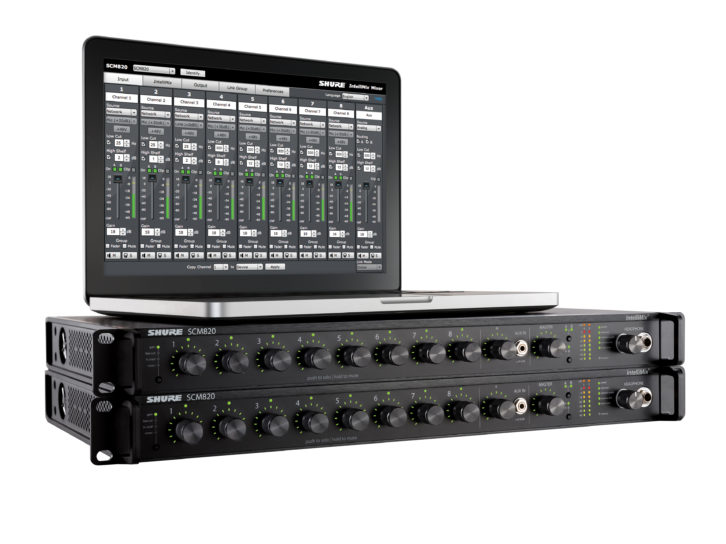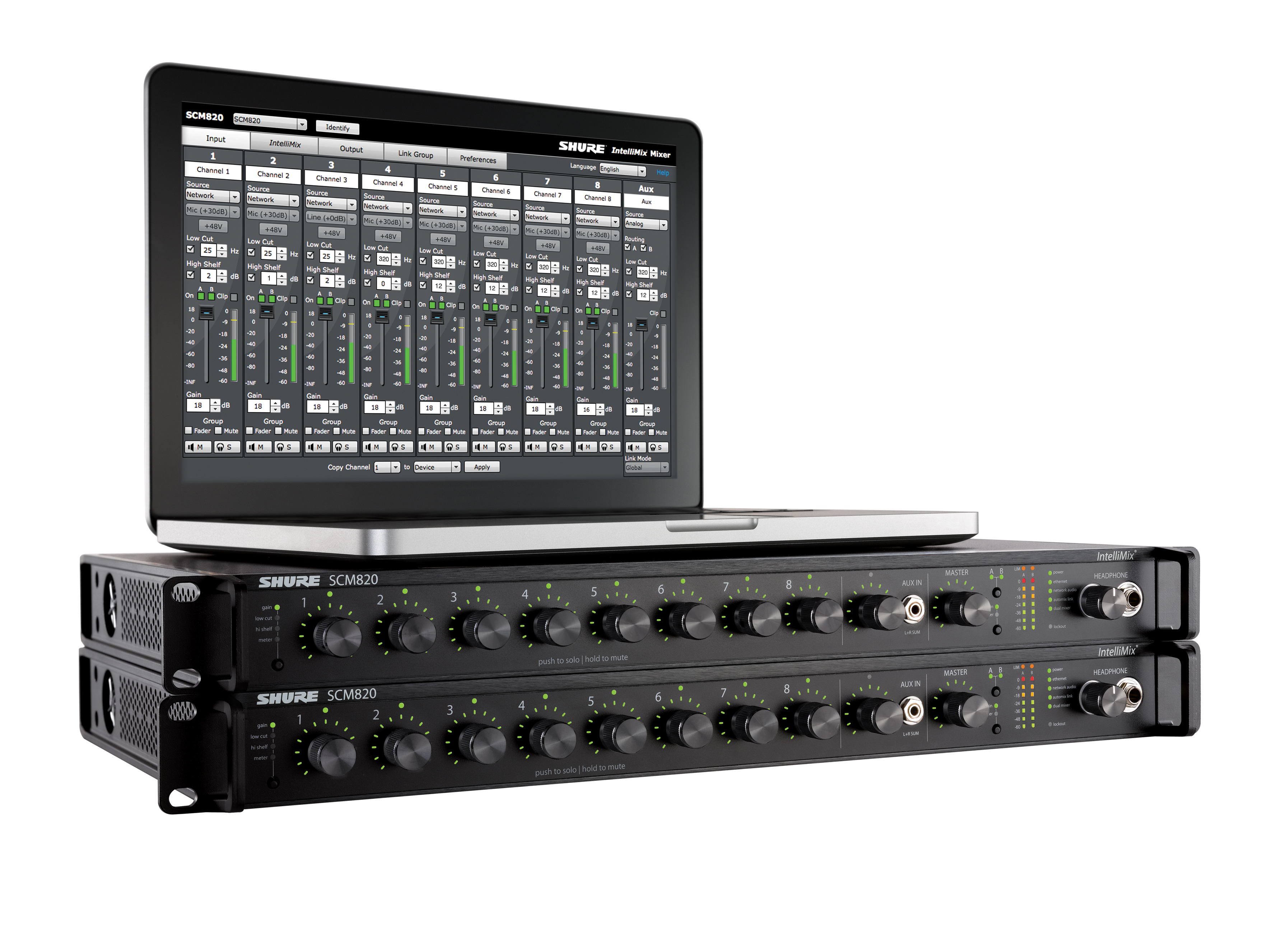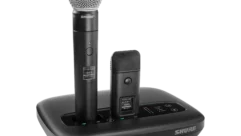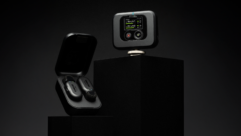

The Shure SCM800 microphone mixer is seemingly ubiquitous, gracing the racks of myriad installations—boardrooms and ballrooms alike. In its broad wake, Shure introduced an automixing version of the SCM800, known as the SCM810. And more recently, the SCM820 has been announced, with substantial and sophisticated updates. I was charmed to see that the front panel of the latest revision is clearly recognizable as a descendent of the original SCM800—but behind the panel lurks a vastly more powerful suite of tools that go far beyond blending eight inputs into a single output signal. Powerful automixing conventions are standard and Dante digital audio networking is available—the protocol that has appeared in so many products recently that it appears to have been adopted as a standard, or so it seems. The four versions of the SCM820 comprise the four possible permutations considering Euroblock or DB-25 analog I/O options and the option to include built-in Dante networking. An aftermarket Dante upgrade for analog-only SCM820s is available, as well. I evaluated a unit with Euroblock I/O and no Dante capabilities.
While the front panel of the SCM820 is similar to that of its predecessors, it grants much more control. A pushbutton at the left end of the panel scrolls through four modes determining the function of the eight channel knobs and their metering: gain, low cut, hi shelf, and meter. All four are self-explanatory, the name describing the function. The unit’s low-cut filter can be swept from 25Hz to 320Hz, and its slope is 12dB/oct. The high shelf’s corner frequency is fixed at 5kHz, it slopes at 12dB/oct, as well, and offers boost or cut of 18dB. The channel knobs are surrounded by 13-segment LED meters, which are activated in meter mode. Above each knob is an additional, solitary LED that indicates channel status (channel selected or attenuated in the automix, EQ engaged or bypassed, clipping, and channel muting). The knobs are also pushbuttons: they solo individual inputs to the headphone output when pressed momentarily, and when pressed and held, mute the channel or bypass equalization, whichever is selected. To the right of the eight channel knobs is the unit’s auxiliary input, which is mirrored on the rear panel and has its own control knob and metering LEDs like the other channels. The only attribute of the auxiliary that does not remain true to the SCM820’s ancestors is the choice of a 2.5mm jack instead of a 1/4in. socket, ostensibly to handle the output of a handheld device like a smartphone or MP3 player easily via the front panel.
Moving rightward, the next item is a multi-function master level knob (with LED metering like the others), and a pushbutton that determines the function of the master knob and its LEDs (gain or limiting). Additional LEDs indicate the master knob’s status, along with dual mixer status, limiter engagement, and system status (power, Ethernet connection, network audio, automix linking, dual mixer engagement, and lockout). There are also dual seven-segment level meters and a 1/4in. headphone jack with a level control knob.
The rear panel features, starting at the left end, an IEC AC power inlet and rocker power switch, followed by audio I/O: either Euroblock or DB-25 for principal audio connections. The DB-25 version offers XLR main outputs for both A and B mixes, and a stereo pair of RCA inputs, which are summed to mono. There are two DB-25 terminals, one for the eight channel inputs, and one for direct outputs, which are represented by three-conductor Euroblock jacks on the Euroblock version. Each channel input has a total of seven conductors: audio positive, negative, and ground, and logic gate out, mute in, override in, and a common logic ground. The Euroblock version offers an additional ground screw per channel, intended for cable-shield grounding. To the right of the audio I/O are found controls and LED indicators. Specifically, there are two buttons that determine which of the five Intellimix modes is selected for the A and B mixes, respectively, along with a single pushbutton that determines whether dual mix mode is engaged at all. Another pushbutton scrolls through the nine input channels (eight principal and one auxiliary) to determine which will be controlled and displayed by an additional group of controls and indicators. This group determines gain range (pad) status, phantom power, and auto-linking (which facilitates the creation of groups consisting of inputs from multiple SCM820 units). Individual LEDs indicate all these states, and a seven-segment numerical LED display indicates to which channel changes are being applied. A pair of recessed pushbuttons and corresponding LEDs engage and indicate system reset and lockout status, the latter of which disables all front and rear panel controls. RJ-45 network jacks are found at the far right end of the rear panel, one in the case of a non-Dante unit, two for Dante-enabled units.
The digital resolution of the SCM820 is 24-bit/48kHz, with internal processing executed with 32 bits of resolution. In its default state, a single SCM820 exhibits less than one millisecond of latency in each of the four possible I/O combinations: analog-analog, analog-Dante, Dante-analog, and Dante-Dante. Latency is only a bit higher with multiple units in play. The A and B main mix buses offer a limiter, low and high shelving, and six bands of true parametric EQ. The system employs three Intellimix automixing principles: noise adaptive threshold, “MaxBus,” and “number of open microphones attenuation (NOMA).” While these three mechanisms existed in the SCM810, the SCM820 makes them configurable in ways the legacy product was not capable. The noise adaptive threshold monitors the noise floor and dynamically changes the level at which a mic opens, based on changes in the room’s noise level. If a single voice kicks open two mics, MaxBus establishes that it’s the same signal on both, and will close one so as to avoid comb filtering. The NOMA function attenuates system gain as additional channels are opened, so as to prevent output levels from creeping up as more signal (and more noise) are added into the mix. Reducing output while increasing input also helps to deliver better gain before feedback, and maintains a natural sounding noise floor in the output (notably during long pauses—the noise floor doesn’t just disappear).
There are five automixing modes available, determined by application: “classic” emulates the SCM810’s fast-acting gating, “smooth” is a “gain-sharing” mode that balances gain across channels, “extreme” is an aggressive version of classic operation with complete attenuation of closed-channel gain, “custom” allows the user to tailor and fine-tune Intellimix parameters to maximize performance in a specific application, and “manual” simply deactivates Intellimix to allow the unit to behave like a standard mixer with EQ, limiting, and mix bus routing.
I have been alluding to A and B mix buses, and indeed, the system offers two discrete outputs, which facilitates the system’s “dual mixer” mode. In “single mixer” mode, all inputs are routed to the same bus, which feeds identical audio to both A and B outputs. Each can have distinct parametric EQ, limiting, and gain settings. In “dual mixer” mode, input signals can be sent to both mix buses, each with its own intelligent mixing algorithm, facilitating two discrete and simultaneous output signals appropriate for two distinct destinations. An example: mix A in classic mode for sound reinforcement and mix B in smooth mode for broadcast. I really like this functionality and can think of at least one recent install I did that would benefit tremendously from it. I’m also thrilled with the inclusion of signal distribution via Dante—this opens up a whole new world of possibilities. Remote control of the mixer via external hardware and logic (e.g. AMX, Crestron, etc.) is not new, but is still very useful in a world in which clients wish to keep the remote functionality they’ve always had while incorporating the new capacities of the SCM820. And in terms of remote control of the system, it just doesn’t get any better than the browser-based GUI that facilitates monitoring and control of every single SCM820 parameter, particularly if multiple units are in play. This is very powerful, and vastly simplifies installer configuration and even facilitates user-end control in some cases.
The Shure SCM820 is indeed easy to implement, configure, and prepare for use by end users. It recalls the classic SCM800 and SCM810 units, but brings in a huge amount of new and very powerful functionality, and is well worth the price of admission. If you specify intelligent automixers for any installations whatsoever, you really need to take a close look at the SCM820.
PRODUCT SUMMARY
Product: SCM820 Automixer
Pros: Powerful intelligent mixing, audio networking, useful presets, dual mix mode
Cons: Difficult to read tiny print on unit
Applications: Sound reinforcement, broadcasting, audio recording, corporate AV
Price: $2,374 to $3,124 ($1,899 to $2,499 street) based on configuration
SPECIFICATIONS
Dynamic Range (20Hz-20kHz, A-weighted, typical)
Analog-to-Analog: 110dB
Analog-to-Dante / Dante-to-Analog: 113dB
Output Noise (mix output/direct output,
20Hz-20kHz, one channel open)
Line (output pad +0dB): -90dBV
Aux (output pad -20dB): -110dBV
Mic (output pad -46dB): -135dBV
Equivalent Input Noise (20Hz-20kHz, A-weighted,
input terminated w/150Ω, digital gain @ +18dBV)
Line (input gain +0dB): -93dBV
Mic (input gain +26dB): -118dBV
Mic (input gain +46dB): -130dBV
THD+N (1kHz, +4dBU out
Mix output (MASTER) at +0dB): <0.05%
CMRR (150Ω balanced source @ 1kHz): >70dB
John McJunkin is the principal of Avalon Podcasting in Chandler, Ariz., and produces and co-hosts a top-rated morning radio talk show in Phoenix. He has consulted in the development of studios and installations and provides high-quality podcast and voice production services.










